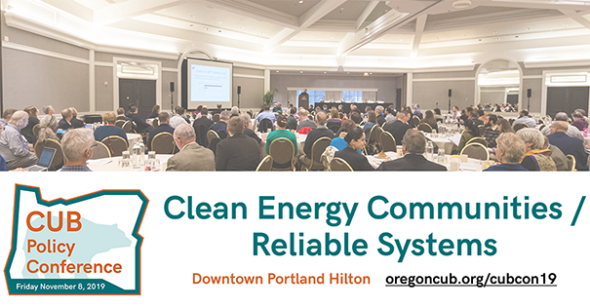CUB Conference Preview: Capacity Realities
Posted on September 26, 2019 by Mike Goetz
Tags, Conference & Events

The ninth annual CUB Policy Conference, Clean Energy Communities / Reliable Systems, will take place on Friday November 8 at the Downtown Portland Hilton. Tickets are still available and we are now only two weeks away from the October 11 Early Bird Deadline – register today to secure your seat at the table! I’m pleased to offer the fourth installment of our blog series previewing each of our six breakout panels – today we discuss the panel Capacity Realities: Avoiding a Regional Resource Shortfall.
While many of the pieces to the puzzle that is the future of the Pacific Northwest electric system remain uncertain, one thing is clear: as a region, we need to plan for, and build or otherwise acquire, adequate capacity to meet our peak needs. This wasn’t always the case. Due to a variety of factors—including energy efficiency and historical loss of industrial load—for a long time our robust hydroelectric system has been able to meet the capacity needs of our region on the coldest winter days that required the most electricity generation. We are entering a new era here in the Pacific Northwest, however, and recent scarcity events may be a harbinger of what’s to come unless we take a hard look at our region’s needs.
What is this new era, you ask? According to an in-depth study authored by Energy + Environmental Economics (E3), the Pacific Northwest is expected to undergo significant changes to its electric generation mix over the next 30 years. This is, in part, due to changing economics of various resources: variable renewable generating resources continue to decline in cost, while baseload fossil fuel resources like coal plants are continually retired due to unfavorable economics. Further, state and regional environmental policy legislation, such as Washington’s 100 percent clean electricity bill and Oregon’s Coal to Clean bill, mandate that more and more electricity must be procured from renewable energy. Regional policies have similarly eschewed further investment in baseload fossil fuel plants.
Regional experts and studies like E3’s have predicted that much of our future capacity will come in the form of energy storage (such as batteries and pumped hydro) and front office transactions (FOTs) and market purchases. FOTs will become increasingly available as a capacity resource as the Western Energy Imbalance Market (EIM) footprint continues to expand and our region’s sole regional transmission organization, CAISO, rolls out its shiny new Extended Day-Ahead Market. However, capacity is at its most useful when it is firm—that is, it can be dispatched to provide energy at a moment’s notice. While market purchases can help alleviate some concerns, difficulties arise when there are transmission constraints and other complicating factors.
What is the answer, then, to the complex capacity dilemma our region is facing? There are many facets to this issue, and we will hear a wide range of opinions from our expert panelists hailing from diverse backgrounds. We look forward to the conversation, and I hope you can join us! Appearing on the Capacity Realities: Avoiding a Regional Resource Shortfall panel will be:
- Ryan Bracken - Principal Economist, NW Natural
- John Fazio - Senior Systems Analyst, NW Power & Conservation Council
- Ryan Hardy - Principal, Hardy Energy Consulting
- Elaine Hart - Manager, Integrated Resource Planning, Portland General Electric
- Erik Steimle - Vice President of Project Development, Rye Development
CUB appreciates our panelists for their contributions to what will surely be a lively discussion. Visit the CUB Conference website for more info on these and other panelists, as well as supplemental reading materials, travel information, and more! For those traveling from outside of Portland, note that CUB has a discounted room block set aside at the Duniway Hotel for conference guests – this discount is available until Saturday October 5 – contact CUB Communications Manager Amelia Lamb at (503)227-1984 x17 or .(JavaScript must be enabled to view this email address) for more information.
We are also grateful to our generous sponsors for making this event possible – particularly Polar Bear sponsors NW Natural, Pacific Power, and Portland General Electric; Brown Bear sponsors Avangrid Renewables, Bonneville Power Administration, Idaho Power, NW Power & Conservation Council, and Oregon Department of Energy; and Media Sponsor Clearing Up. Keep up with CUB Conference news by signing up for our email list, and on Twitter at #CUBCon19!
To keep up with CUB, like us on Facebook and follow us on Twitter!




09/26/19 | 0 Comments | CUB Conference Preview: Capacity Realities